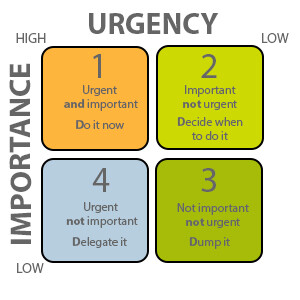Elevate Your Time Management with a 4-Quadrant Approach
If you’re new to our weekly entrepreneur newsletter, welcome! Each week we research the issues that matter most to small business owners and entrepreneurs, then share insights, strategies, and expertise to help you solve challenges and achieve your goals. We hope you enjoy today’s edition!
In This Issue
- Why Most Entrepreneurs Struggle with Constant Firefighting
- A Principle-Based View of Time Management (Beyond Quick Fixes)
- Understanding the Four Quadrants of Time Management
- Practical Tips for Prioritizing What Truly Matters
Why Most Entrepreneurs Struggle with Constant Firefighting
Many entrepreneurs wake up each morning feeling like they’re already behind. They dash between meetings, tackle customer emergencies, and end the day too exhausted to focus on big-picture projects. Work–life balance feels impossible, and the latest “miracle” productivity hack never sticks—because it doesn’t address the root problem: reacting to every urgent demand.
A Principle-Based View of Time Management
Instead of sorting tasks by urgency alone (“Is it due now or can it wait?”), a higher-level framework also factors in importance. When you prioritize activities that align with your values and vision, you move from firefighting to foresight.
Understanding the Four Quadrants of Time Management
This simple framework categorizes every task by urgency and importance:

Quadrant 1: Urgent & Important
Immediate demands—client crises, looming deadlines. Living here means constant stress and no breathing room.
Quadrant 2: Important & Not Urgent
Strategic activities—planning, systemizing, relationship-building (including with loved ones!). These fuel growth and balance, yet often get sidelined.
Quadrant 3: Urgent & Not Important
Interruptions—nonessential meetings, emails, or “busy work” that feels pressing but contributes little.
Quadrant 4: Not Urgent & Not Important
Mindless downtime—endless scrolling or binge-watching shows—that serves as a tempting escape after too much Q1 stress.
Why Entrepreneurs Get Trapped in Q1 & Q4
Wearing all the hats makes it easy to react to every immediate need (Q1) and then crash into burnout activities (Q4). Over time, this cycle destroys work–life balance and sidelines vital long-term projects.
Practical Tips for Prioritizing What Truly Matters
- Schedule “Important” Time: Block calendar slots for Q2 work—strategy, process improvements, or personal growth—and treat them as immovable appointments.
- Categorize Your Tasks: Label activities as Q1, Q2, Q3, or Q4. Track where your time goes to spot patterns and decide what to delegate or discard.
- Systematize & Delegate: For recurring Q1 emergencies, document a standard response and empower a team member (or automate) to handle them.
- Protect Your Energy: Structure restorative breaks instead of unplanned Q4 escapes. Choose activities that genuinely recharge you.
- Set Small Milestones: Focus on one Q2 initiative at a time. As you invest in prevention, you’ll see fewer fires and a snowball effect of increased capacity.
Effective time management isn’t about cramming more tasks into your day; it’s about ensuring the tasks you do align with your priorities and principles. By valuing importance as much as urgency, you create space for vision-driven work—and regain control of your business and life.
Schedule Your Free Strategy Session
See you next week!







